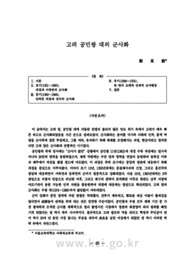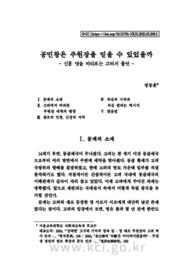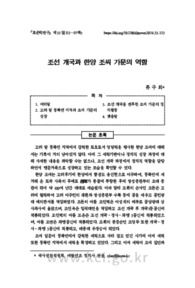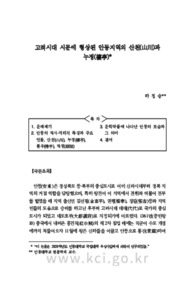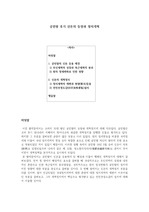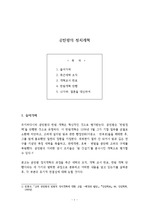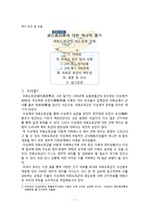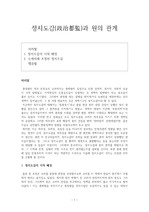

-
미리보기
서지정보
· 발행기관 : 진단학회
· 수록지 정보 : 진단학보 / 142호 / 65 ~ 100페이지
· 저자명 : 정동훈
초록
이 글에서는 고려 말, 공민왕 대에 거듭된 전쟁과 풀리지 않은 안보 위기 속에서 고려가 매우 빠른 속도로 군사화되었음을 시간 순으로 살펴보았다. 군사화라는 용어를 국가와 사회의 인적, 물적 역량을 군사력에 집중 투입하고, 그를 지속, 유지하기 위해 체제를 조정해가는 과정, 현상이라고 정의한다면 고려 말은 군사화의 전형적인 시기였다.
공민왕의 즉위 당시에는 “군사가 없던” 상황에서 공민왕 11년(1362)의 개경 수복 작전에는 일시적이나마 20만의 병력을 동원하였으며, 재위 막판에는 수만 명의 병력을 연달아 동원하여 압록강 이북과 제주에서 작전을 펼칠 정도에 이르렀다. 이 과정은 즉위 초기에는 중앙의 정변에 대응하기 위해 개경을 중심으로 이루어졌다. 이어서 초기 10년, 1350년대에는 몽골제국과의 긴장, 그리고 홍건적의 침입에 대응하면서 서북면과 동북면의 군비가 집중적으로 강화되었다. 다음 10년, 1360년대에는 2차 침입으로 국왕이 안동으로 피난한 이후, 그리고 왜구의 침략이 본격화된 이후로 한반도 남부 지방에 이르기까지 동원 가능한 인적 자원을 총동원하여 외침에 대응하는 양상으로 확산되었다. 고려 말의 군사화는 우왕 대(1374~1388)까지 끊임없이 지속되었다.
군비 강화가 중앙 정치에 끼친 영향은 막대했다. 전투가 계속되고, 軍功을 세운 이들이 출세길을 달리면서 武將들이 권력을 쥐게 되는 것은 당연한 수순이었다. 공민왕과 우왕 모두 재위 기간 중 가장 철저하게 조직된 군사를 계획적으로 멀리 출병시킨 시점에서 정변의 희생양이 되어 왕위를 빼앗기게 되었다는 점 역시 매우 시사적이다. 결과적으로 고려 왕조의 막을 내리고 혁명의 주인공이 된 이 역시 30여 년 동안 가장 빛나는 무공을 세우며 武名을 날린 이성계가 되었던 점 역시 이러한 맥락 속에서 자연스럽다.
고려 말의 사회경제적 변화 역시 군사화 경향과 떼려야 뗄 수 없다. 조선 건국을 주도했던 이들이 고려 말기의 폐해로 가장 적극적으로 거론했던 이른바 私田 문제 역시 각지로 파견되었던 장수들이 가장 큰 주범으로 지목되었다. 이들이 전국에 걸쳐 광대한 사전을 집적한 것은 그들이 몰고 다닌 무력이 있었기 때문에 가능했다.영어초록
This article chronologically examines the rapid militarization of Goryeo amidst repeated wars and unresolved security crises during the reign of King Gongmin in the late Goryeo period. As a result, the country went from “no army” at the time of King Gongmin's accession to the throne, to a temporary mobilization of 200,000 troops to restore Gaekyong in King Gongmin's 11th year (1362), and to a continuous mobilization of tens of thousands of troops in the final years of his reign to operate in the north of the Apnok River and Jeju Island. This process was characterized by a sequential pattern of militarization, focusing on Gaekyong in the early years of his reign in response to the central political situation, and in the following decade in response to tensions with the Mongol Empire and the Red Turban’s invasion, in the northwest and northeast, after King Gongmin fled to Andong, and after the Japanese invasion began in earnest, in the southern part of the Korean peninsula The militarization of the late Goryeo period was repeated throughout the reign of King Woo (1374-1388), when relations with Ming rapidly deteriorated, leading to military conflict, and the entire Korean peninsula was plagued by Japanese hordes. As a result, in the last year of King Woo's reign (1388), he organized an army of up to 50,000 troops and advanced as far as Wihwado to conquer Yodong. This was exactly twice the number of troops that landed on Jeju in the last year of King Gongmin.
The impact of the military buildup on central politics was enormous. As the battles continued and the men who had established military success rose to prominence, it is no wonder that warlords rose to power. It is also very significant that both King Gongmin and King Wu fell victim to political changes and lost their thrones at the point in their reigns when they had deliberately sent their most thoroughly organized armies far away. It is also natural in this context that the man who ended the Goryeo dynasty and became the protagonist of the revolution would also become Lee Sung-gye, the most prominent martial artist of the next three decades.
The socioeconomic changes in Goryeo are also inseparable from the militarization trend. The so-called Sajeon problem, which the founders of the Joseon Dynasty most actively cited as a problem of the late Goryeo Dynasty, was also blamed on the generals who were dispatched to various parts of the country. The vast collection of dictionaries across the country was only possible because of the military force they traveled with. The local elites, or “閑良,” who are said to have supported and sustained the founding of the Joseon Dynasty, were also the ones who confirmed their existence and gained social influence amidst the trend toward militarization.참고자료
· 없음태그
-
자주묻는질문의 답변을 확인해 주세요

꼭 알아주세요
-
자료의 정보 및 내용의 진실성에 대하여 해피캠퍼스는 보증하지 않으며, 해당 정보 및 게시물 저작권과 기타 법적 책임은 자료 등록자에게 있습니다.
자료 및 게시물 내용의 불법적 이용, 무단 전재∙배포는 금지되어 있습니다.
저작권침해, 명예훼손 등 분쟁 요소 발견 시 고객센터의 저작권침해 신고센터를 이용해 주시기 바랍니다. -
해피캠퍼스는 구매자와 판매자 모두가 만족하는 서비스가 되도록 노력하고 있으며, 아래의 4가지 자료환불 조건을 꼭 확인해주시기 바랍니다.
파일오류 중복자료 저작권 없음 설명과 실제 내용 불일치 파일의 다운로드가 제대로 되지 않거나 파일형식에 맞는 프로그램으로 정상 작동하지 않는 경우 다른 자료와 70% 이상 내용이 일치하는 경우 (중복임을 확인할 수 있는 근거 필요함) 인터넷의 다른 사이트, 연구기관, 학교, 서적 등의 자료를 도용한 경우 자료의 설명과 실제 자료의 내용이 일치하지 않는 경우
“진단학보”의 다른 논문도 확인해 보세요!
-
閭巷文學으로서의 『華東唱酬集』 : 『華東唱酬集』의 성립과 19세기 말 譯官의 緣脈 32 페이지
譯官 金秉善(1830~1891)은 『華東唱酬集』 을 편찬하며 閭巷人 작품의 집성을 기획하거나 閭巷文學 관련 문헌의 계보를 의식하지 않았던 것으로 보인다. 따라서 『화동창수집』 은 여항인에 의해 만들어지고 그들의 자료를 수록하였으되 전적으로 여항문학사의 線上에 올려두고 그 의미와 위상을 따지기에는 違和感이 없지 않다. 다만 오늘날 여항문학의 새로운 자료를 발.. -
충청도 방언의 해유체 종결형 ‘있어유’>‘있유’의 변화에 대하여 23 페이지
이 글은 충청도 방언의 특이 활용형 ‘있유(있어요)’, ‘청국장이유(청국장이에요)’, ‘가슈(가세요)’ 등의 형성 과정을 해명하고, ‘ㅓ’>‘ㅔ’>‘ㅣ’ 견인 현상의 존재를 제안한다. ‘ㅓ’의 견인은 ‘{ㅅ, ㅆ, ㅣ, j}_j’의 환경, 곧 전설성 요소가 ‘ㅓ’의 앞뒤로 연접하는 조건에서 발생하며, ‘있-’, ‘-이-’, ‘-으시-’ 부류처럼 사용 빈도가.. -
17세기 養家의 재산상속과 繼後子의 역할 22 페이지
본 연구는 17세기 분재기 분석을 통하여 양가의 재산상속과 계후자의 역할을 고찰하였다. 첫째, 17세기 전반 계후자와 친딸을 대상으로 균분상속이 행해질 때는 윤회봉사도 함께 이루어졌다. 따라서 이 시기의 계후자는 친딸과 동등한 견지에서 봉사의 일부를 담당한 것으로 파악된다. 둘째, 17세기 후반 계후자와 친딸을 대상으로 차등상속이 시작될 때는 계후자에 의한.. -
인조대 元孫(石鐵) 北行의 함의와 世孫冊封論 36 페이지
병자호란 직전 태어난 소현세자의 장자인 원손은 강화도가 함락될 때 탈출하였고, 세자 부부가 청에 끌려갈 때도 조선에 남았다. 인질이 된 세자와 봉림대군의 안전을 보장할 수 없는 상황에서 원손은 종묘사직의 보존을 상징하는 동시에 인조의 후계 구도를 보여줌으로써 왕권의 동요를 막을 수 있는 존재였다. 소현세자가 두 차례 귀성하면서 원손이 세자를 대신하여 심양으.. -
고대 연못 유물의 주술적 의미 25 페이지
연못은 자연적으로 형성되거나 인위적으로 조성된 물 저장 시설로, 주로 농업용 관개, 궁궐 및 귀족 저택의 조경, 산성의 군사용 방화수 및 생활용수 확보 등의 목적으로 사용되었다. 그러나 산성의 연못에서는 음용수와 무관한 유물들이 출토되어 주목받고 있다. 이는 산성이 외적을 막는 요새이자 지방 행정의 거점으로서 공적 의례를 수행하는 장소였음을 시사한다. 문헌..
찾으시던 자료가 아닌가요?
지금 보는 자료와 연관되어 있어요!
문서 초안을 생성해주는 EasyAI
